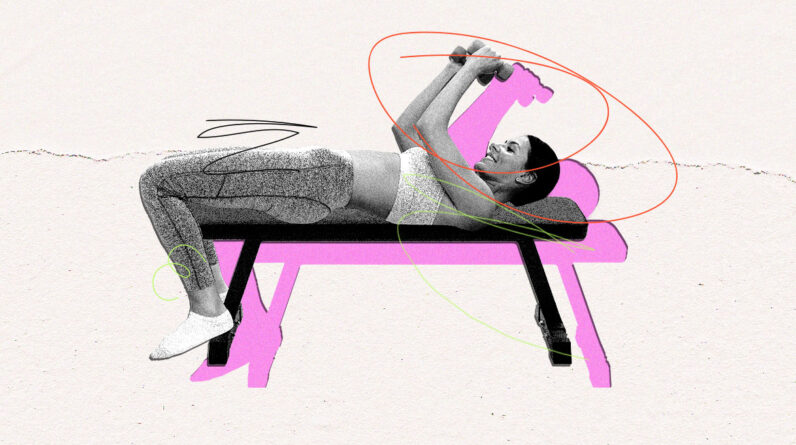
Sure, there are tons of ways to train your upper body. But if you truly want to target your triceps—and, BTW, you totally should (more on why later)—start doing skull crushers. Also known as nose breakers, skull crushers work a couple of muscles and involve lying on your back and lowering weight to your forehead. And they sound, well, pretty intimidating. But don’t let the name scare you off: As long as you practice good form, these lying triceps extensions are super safe.
Skull crushers are also extremely effective at building bigger, stronger triceps. Plus, they’re also pretty easy on your elbows (compared to other overhead triceps extension exercises) and boost your bench press prowess, too.
Got your interest? Read on to learn how to do skull crushers correctly, exactly which muscles the move works, and all the plusses it has to offer.
How to do skull crushers with perfect form every time
You can do skull crushers in a bunch of different ways: holding onto dumbbells, a barbell, EZ bars, weight plates, and even resistance bands; you can lie on the floor or a bench. Each variation will work your triceps.
Whichever way you choose, follow these general steps to get the proper form with skull crushers.
- Lie on a bench or the floor, holding a dumbbell in each hand.
- Extend your arms above your head, so they’re directly above your shoulders.
- Bend your elbows, slowing lowering the dumbbells toward your forehead with control, then press back up.
Don’t ignore persistent pain. As you crank out your last few reps, your triceps may burn and shake (that means they’re working to failure), and they may even be a little sore for a few days after. But pain of any kind is not normal. If it hurts when you do skull crushers, stop. “If you are experiencing lingering pain after performing skull crushers, it’s best to see a licensed professional,” Sanchez says.
Muscles worked when doing skull crushers
Skull crushers focus on strengthening your triceps, the muscles located on the back of your upper arm, says Kyle Sanchez, PT, DPT, CSCS, physical therapist and certified strength and conditioning specialist at Bespoke Physical Therapy in New York City. While training the triceps often gets overlooked (many gymgoers spend all their time building bigger biceps), this muscle is massively important for arm function.
“Broadly, the triceps muscle extends the arm at the elbow joint and assists in keeping the humerus stable within the socket,” says Karina Wait, a personal trainer at Life Time Edina in Minnesota. Both things are essential for everyday activities (think: brushing your teeth, combing your hair, reaching for something on a high shelf). Really, any time you bend or straighten your arms, your triceps are at work.
The triceps is capable of all this because it’s a three-headed muscle (this is also where the tri in triceps comes from). “The triceps consist of three separate heads that converge into a single tendon at the elbow,” Sanchez says.
- The long head (stabilizes the shoulder joint, extends your arm at the shoulder, and helps move your arm across the body)
- The medial head (plays a vital role in extending the forearm at the elbow)
- The lateral head (the strongest of all three heads, also helps with elbow extension)
“Skull crushers work all three heads of the triceps,” Wait says. “However, the medial head is the star of the show.” Compared to the other two heads, it’s active in all forms of triceps extension (including the sphinx push-up).
While the triceps is the main muscle targeted in skull crushers, there are other muscles that support the movement. Additional muscles worked during skull crushers, according to Wait:
- Deltoids: stabilize the shoulder joint during the skull crusher
- Upper back and lats: stabilize the entire body on the bench
- Forearm muscles: stabilize the weight during the movement
5 benefits of skull crushers that’ll convince you to add them to your workouts
If they’re not already, skull crushers should be a staple in your weekly workouts. Here are just a few reasons why.
1. They isolate and build the triceps
Whenever you bend or extend your arm, your triceps are be involved, making strong, healthy triceps a top priority.
To train your triceps properly, you have to isolate the muscle. And skull crushers do just that: “Because they target all three heads of the triceps, it’s a great bang for your buck exercise,” Wait says.
Plus, the position of the movement (lying on your back) takes momentum out the equation. With standing exercises, we can use momentum to lift the load (especially after a few reps, when it’s starting to feel heavy). The problem with that is you don’t get the full benefit of the move. Skull crushers don’t give us any room to cheat ourselves.
2. They support shoulder health
The long head of the triceps attaches to the scapula, your shoulder blade. “More specifically, the long head contributes to extension and adduction at the shoulder joint,” Wait says. It also plays a pivotal part assisting with shoulder joint stability, she says.
So skull crushers, which strengthen the long head, can help maintain healthy shoulder function and combat shoulder weakness. Shoulder pain is super common (over 2 million Americans see their doctor for it every year, per the Cleveland Clinic), so consider adding skull crushers to your regular routine as a preventive strategy.
3. They promote healthy elbow joint function
Strong triceps are essential for elbow extension. Again, “all three heads [of the triceps] are responsible for straightening the arm at the elbow,” Sanchez says. Skull crushers strengthen all three heads, so they cover all the bases.
On top of this, “by bringing the elbow joint through its natural range of motion, skull crushers can also help improve blood flow, increase stability at the elbow, and enhance overall joint health,” Sanchez adds.
4. They increase pressing strength
Has your bench press progress stalled lately? Start cranking out skull crushers to build bigger triceps.
“Stronger triceps can help you overcome ‘sticking points’ in exercises like the bench press,” Sanchez says. The triceps are in control of elbow extension, so they’re crucial for movements like pressing. They serve as important accessory muscles and “act as synergists during pressing motions,” he says.
5. They’re a good alternative for people who have pain with overhead movements
Do you wince when you lift your arms above your head? If so, you should steer clear of certain triceps exercises like overhead extensions.
Luckily, skull crushers—which are performed while lying on your back with the arms at shoulder height—are an awesome option for peeps with shoulder pain, Sanchez says.
Wait seconds this: “Because the shoulder and wrist joints are unmoving, and the exercise is performed in a supine position, lifters can perform deep elbow flexion [without pain] compared to other exercises.”
7 common mistakes when doing skull crushers
With skull crushers, proper form is fundamental. Poor technique not only makes the exercise less effective, but it can also make it less safe (they are called skull crushers, after all). Here’s how to sidestep the most common mistakes (and avoid any unwanted accidents).
1. Flaring out your elbows too much
“Keep elbows locked in and do not let them move,” Wait says. “If you can’t keep your elbows tight and stacked with the shoulders, lower the weight,” Sanchez adds.
2. Moving your upper arm into extension
Your upper arms should stay stationary. “Make sure you are extending only from the elbow to maximize the benefit of skull crushers,” Sanchez says.
3. Moving your wrists
Just like your upper arms, your “wrists and forearms should be still throughout the movement,” Wait says. If you need a visual: “there should be a straight line from your elbow to your forearm to your knuckles,” she says.
4. Lifting too heavy
This can put an immense amount of pressure on the elbows and wrists, Wait says. Plus, as the name of exercise implies, you can really hurt yourself if the weight is too heavy, and you drop it on your head, she says.
All this to say, “staying at light to moderate loads is the best plan of attack,” Wait says, and Sanchez agrees.
“Overloading the elbow joint too quickly may lead to poor technique and increased injury risk,” he says. As you grow stronger, you can slowly increase the weight over time.
5. Not controlling the descent or ascent
The real muscle work happens with slow, controlled movements.
Again, safety is the top priority. “Choose weights that allow you to have complete control of all phases of the movement,” Wait says.
6. Your grip is too wide (or too narrow)
To truly target the triceps, your “grip should be about shoulder-width apart,” Wait says. This distance will also help you maintain control over the movement.
7. Not going low enough, or not fully extending the elbow at the top
To get the most out of the movement, use your full range of motion. That means when you lower the weight, “make sure to bend your elbow until it cannot bend anymore,” and when you lift it back up, “fully straighten the elbow at the top,” Wait says.
Modifications for skull crushers
Skull crushers can be straight up strenuous. Luckily there are plenty of ways to adjust the exercise for every fitness level and situation. And don’t get it twisted: modifying doesn’t mean easier. These variations will still light your triceps on fire.
Decrease the weight
The good news: you don’t need to lift heavy to tax your tris. A light or moderate load will work the muscle.
Reduce the reps
Just like you can adjust the weight, you can also do fewer reps. Again, as you build strength, you can add more reps and sets.
Try different equipment
Sometimes your gear is the issue. For example, maybe you’re finding it awkward to hold a barbell, or it’s hard on your joints. Fortunately, “skull crushers can be performed with barbells, EZ bars, dumbbells, and even plates,” Sanchez says. Switch up your equipment and see what works best for you.
Try a different type of triceps extension
Skull crushers still not working for you? No biggie. “The seated triceps extension machine is a great alternative,” Sanchez says. Because it doesn’t involve overhead movements, it’s also a good choice for folks with shoulder pain.
FAQ
Which is better: close grip bench or skull crushers?
When it comes to triceps-strengthening exercises, skull crushers are the clear winner, hands down. They are better “for isolating the triceps as they are a single joint exercise primarily involving the elbow,” Sanchez says.
Wait puts it like this: “Skull crushers will target the triceps more than a close grip bench press because of how much stretch is placed on the muscle.”
On the other hand, “the close grip bench press calls in your chest as well as anterior deltoid muscles, making it less focused on the triceps,” Sanchez says. (This is also true for the fan-favorite face pull exercise).
Wait agrees the triceps play second fiddle to the chest muscles in the close grip bench press: “The close grip bench press uses the triceps as an accessory muscle to the pecs.”
However, if skull crushers cause you any elbow pain, “the close grip bench press may feel better,” she adds.
Should you do skull crushers on push or pull day?
Both Sanchez and Wait say skull crushers belong on push day.
When incorporating the movement in your push program, “place it at the beginning of your workout when the muscle is fresh if your main focus is to increase triceps size and/or strength,” Wait says. Otherwise, feel free to experiment with the order of exercises.








